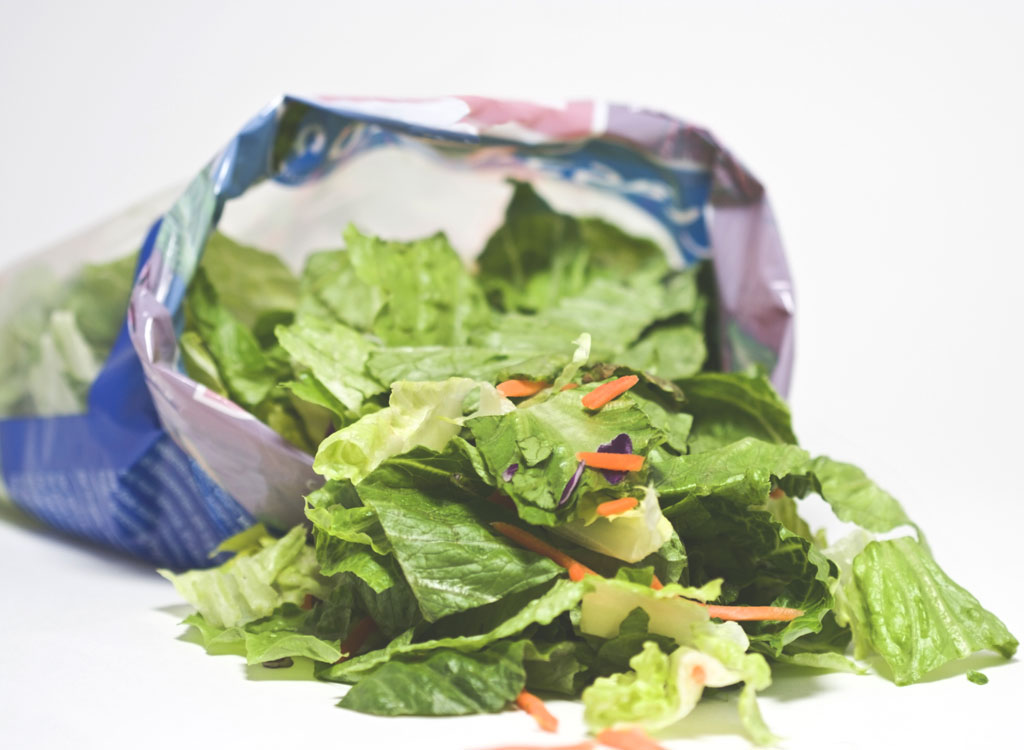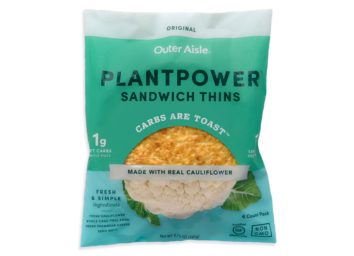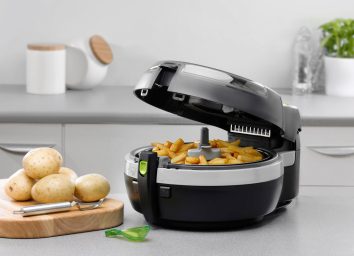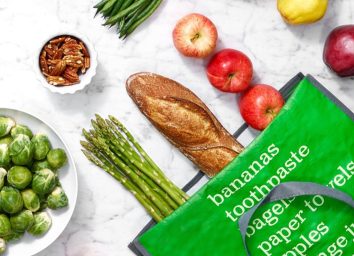The Truth About Picking the Right Bagged Salad

If you’ve ever bought bagged salad before, you’ve probably dealt with the feelings of dread and frustration that arise when you discover that your mixed greens are already infected with a foul smell and revolting slime. Ugh.
While we’re big fans of convenient, healthy foods like bagged, pre-washed lettuce and salad blends—they’re a huge time-saver for people who toss together a low-calorie lunch at the office and wondrous live-saver for those of us who don’t own a salad spinner (guilty!)—you still have to be cautious when picking the best bag as you would with any other produce item. (And for that, we have 35 Easy Ways to Pick Perfect Produce Every Time.)
Although Reddit user Bradliss shared what seemed to be a savvy supermarket hack to handpick only the flat bags to ensure quality, we did some research and found out this isn’t actually the best pro tip. And in the end, we ended up discovering a useful hack for how you can keep your greens crisp for longer.
But as for a way to bypass the moldering mesclun from the get-go? It’s honestly the simplest hack of them all: look at the expiration date. We explain the science behind it below.
Have Puffy Salad Bags Gone Bad?
Some people think that the flatter a salad bag is will indicate its freshness. When Bradliss shared this hack on Reddit, the user explained the reasoning behind it was that “when the greens are packaged, all of the air is sucked out of the bag. Then, as they age, they give off gas, making the bag puffier.”
It is, in fact, true that cut lettuce releases carbon dioxide gas, but this gas won’t build up much in bagged lettuce due to a unique innovation called modified atmosphere packaging (MAP).
This is How Bagged Lettuce Stays Fresh
Food scientists engineered the plastic packaging in a way that it breathes but also “maintains an atmosphere inside the package that will minimize browning and spoilage,” NPR reports. This bagged atmosphere has a lower level of oxygen and more carbon dioxide and nitrogen than what’s in the natural atmosphere.
Even as the lettuce ages and more carbon dioxide builds up, the plastic bag will actually allow some of the CO2 through the plastic bag and into the outside air, according to the University of Arizona’s Good Agricultural and Handling Practices for Food Safety Certification Training Program site.
Because bagged salads will breathe, the inflation of the bag is not necessarily the best “tell” of the quality of your greens.
Plus, there are two ways manufacturers package bagged salads: in “both ‘pillow’ packs and flat packs,” explained user claro_que (who claims to sell packaged salads to grocery stores) in the same Reddit thread. Even more of a reason to not rely on testing the bloat of your bag.
If the amount of air in a bag doesn’t indicate which pack is freshest, what does?
User claro_que goes on to recommend the “best indicator of freshness is usually the Best By date. Salads are produced with around 16 code days, so you can work backward to figure out when it was packed.” Of course, the hack for finding the best bagged salad is the one you’ve likely been doing this whole time!
How to Maintain Your Salad’s Freshness
Once you rip your MAP bag open, the veggie-preserving gas mixture is disrupted as it’s exposed to more oxygen in our air, which will set your greens on a path to spoilage. So once you’ve popped open that plastic, the secret to keeping your greens fresh is simple: Try to replicate the modified atmosphere at home. (For those who prefer buying fresh heads of lettuce and spinach, you can follow this tip as well!)
First, make sure your greens are washed and dried thoroughly and then place them in a plastic bag.
Before sealing the bag, blow some air into it—the carbon dioxide from your breath works to keep the leafy greens fresh for longer, says award-winning cookbook author Dorie Greenspan in her book Around My French Table, via The Kitchn.
We also like to throw in a dry paper towel in the bag to help absorb any leftover moisture that might have been left on the leaves after their wash.
Ready to dress that salad you’re getting ready to make? We recommend making your own salad dressing with a touch of vinegar and extra virgin olive oil. Just make sure you’re not using one of these 16 Worst Bottled Salad Dressings.








